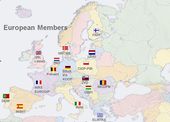
Topic Centre Occupational Safety and Health 2011
Project No. IFA 0095

TC OSH Partners, Picture: DGUV
Status:
completed 12/2011
Aims:
In 2009, the European Agency for Safety and Health at Work (EU-OSHA) set up its Topic Centre Occupational Safety and Health (TC-OSH). TC-OSH is to run for four years. Around 15 projects are conducted each calendar year. The foci in the current year lie upon the areas of workplace health management, protection of non-smokers, management behaviour and OSH, safety and health in waste management, maintenance and construction, reconciling family and work, the spread of OSH management systems, and subject-matter for the effective initial and further training of safety delegates. EU-OSHA has also charged TC-OSH with the task of producing articles for the creation of an international OSH wiki (a wiki for occupational safety and health, similar to Wikipedia). All activities in TC-OSH are geared to implementing the European Commission's strategy on safety and health at work for 2007 to 2012. The principal target of this strategy is a 25% reduction in occupational accidents and diseases in the EU by 2012. With its projects, the European Agency for Safety and Health at Work contributes to this strategy by researching and collecting information on safer workplaces and preparing it for application in OSH in the field.
Activities/Methods:
The work of all projects was divided among the members of an international consortium. In 2011, the IFA was involved in projects on the topics of (1) "workplace health management", (2) "management behaviour and OSH", and (3) "participation at the workplace". In project (1), the task was to determine employers' motivation for the conducting of workplace health management. For this purpose, the IFA conducted a comprehensive literature survey in national and international literature databases. In (2) the IFA identified, again by way of a literature survey, management-related factors for the successful implementation of OSH measures in businesses. In (3), the task was that of presenting examples of successful employee participation, i.e. projects and measures within companies which have the function of involving the employees systematically in the improvement of workplace safety and health. In addition, the IFA was involved in 2011 in setting up an international OSH wiki, and in the management of TC-OSH and of the Topic Centre's Advisory Group.
Results:
The IFA's work relating to (1) "workplace health management", (2) "management behaviour and OSH", and (3) "participation at the workplace" was completed to schedule.
For (1), the IFA identified the factors having an essential bearing upon the introduction and performance of workplace health management. From the employer's perspective, these include: increased commitment on the part of employees, greater efficacy of prevention programmes, reduced lost working hours due to sickness and the associated reduction in sickness benefit payments, better corporate strategies, and improvements to the image of the company or organization owing to the introduction/performance of workplace health management.
For (2), the literature study identified factors for the successful implementation of OSH measures relating to management behaviour. These include: the active involvement of employees in OSH management, and sustained commitment to OSH at all management levels. The success factors and recommendations for policymakers have been summarized by the IFA in a report.
For (3), the IFA analysed and described three case studies: a German example in which employee participation is promoted by a "safety champion initiative", and two Danish examples (the "open door" policy, and systematic meetings and discussions for the reporting of OSH deficits by employees).
In the course of development of a "Wikipedia" on OSH topics, the first articles, dealing with "hazardous substances", were produced under the overall control of the IFA. These included an introductory article by the IFA itself on the subject of "indoor air". In addition, the institute produced two introductory articles on the key topics of "slipping, tripping and falling" and "falls from a considerable height". For the area of "musculoskeletal diseases", an introductory article was produced on "risk assessment of physical work stresses for the prevention of work-related musculoskeletal diseases".
Last Update:
15 Jun 2012Project
- European Agency for Safety and Health at Work
- Institut für Arbeitsschutz der Deutschen Gesetzlichen Unfallversicherung (IFA)
- Bundesanstalt für Arbeitsschutz und Arbeitsmedizin (BAuA)
- Finnish Institute of Occupational Health (FIOH), Finland
- Central Institute for Labour Protection - National Research Institute (CIOP-PIB), Poland
- Hellenic Institute for Occupational Health and Safety (ELINYAE), Greece
- Health and Safety Laboratory (HSL), United Kingdom
- Instituto Nacional de Seguridad e Higiene en el Trabajo (INSHT), Spain
- Instituto Superiore per la Prevenzione e la Sicurezza del Lavoro (ISPESL), Italy
- Hungarian Institute of Occupational Health (OMFI), Hungary
- Prevent, Belgium
- TNO, The Netherlands
- Institut National de Recherche et de Sécurité (INRS), France
- Faculdade de Ciencias e Tecnologia da Universidade Nova de Lisboa (DEMI), Portugal
- The National Research Centre for the Working Environment (NRCWE), Denmark
- Groupement de l'Institution Prévention de la Sécurité Sociale pour l'Europe (Eurogip), France
- National Institute for Research & Development on Occupational Safety "Alexandre Darabont" (INCDPM), Romania
- Institute of Work, Health and Organisations, University of Nottingham (I-WHO), United Kingdom
- Kooperationsstelle Hamburg (KOOP), Germany
- Lithuanian University of Agriculture (LZUU), Lithuania
- Institute of Occupational Safety (ZVD), Slovenia
-cross sectoral-
Type of hazard:-various
Catchwords:Gesundheitsförderung, Unfallverhütung, Arbeitsschutzdienste
Description, key words:risk assessment, risk observatory, work-related risks, good practice, occupational safety and health